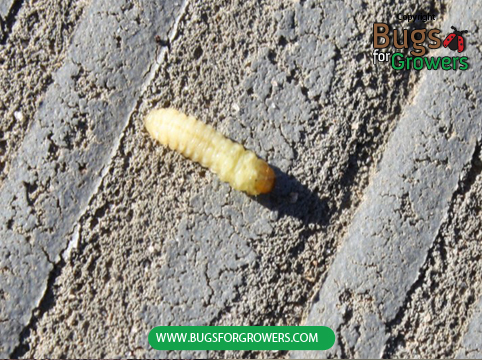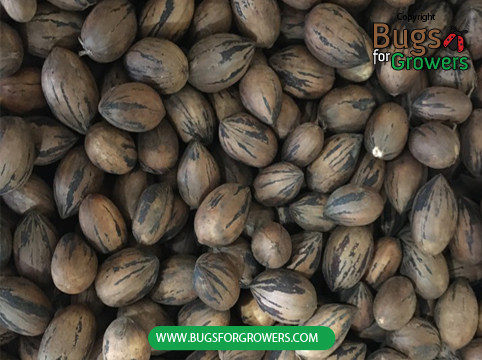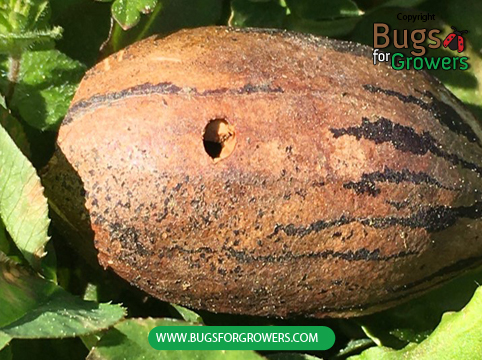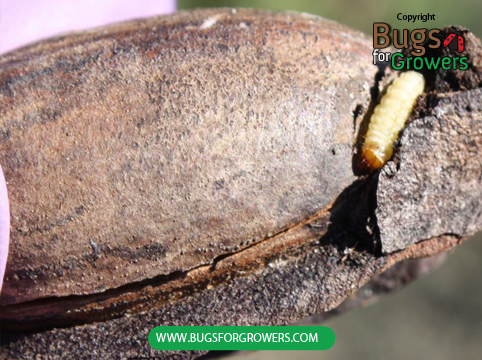How do pecan weevils cause damage to pecan nuts?
Pecan weevils are scientifically called Curculio caryae. Both the adult and larval (Photo 1) stages of pecan weevils cause serious damage to pecan nuts (Photo 2). Damage by pecan weevils generally begins when their adults emerge from the soil- dwelling pupae in late July through August and move to the tree canopy either by crawling on the trunk or directly flying into it. Once in the canopy, adults start puncturing and feeding on the developing young nuts. Some of the punctured young nuts prematurely fall off the trees within 2-3 days. However, female weevils generally chew a small cavity and lay eggs inside the kernel of remaining young nuts on the trees. Eggs hatch into small grubs that immediately start feeding on a developing kernel. Most of these infested nuts prematurely fall to the ground. Other infested nuts will reach maturity but there will be no edible kernels inside the nuts. That is how pecan weevils can cause serious damage to the pecan nuts.
Life cycle of pecan weevils
While feeding on the kernel, pecan weevil larvae will mature to fourth stages inside the nuts within 2-3 weeks. Then mature grubs will cut a small circular hole (Photo 3) through the nut shells, exit the nuts (Photo 4) and then drop to the ground under the canopy. Then grubs will burrow 4 to 8 cm deep in the soil where they will remain in a protective cell for one year and then turn into pupae that remain in the soil for another one year. After a year of pupation, adult weevils start emerging from pupae generally during August. Thus pecan weevils complete their egg- to- adult life cycle within 2 years. This means that both the larval and pupal stages of pecan weevil are present in the soil under the pecan tree canopy all year round and they can be easily targeted with the beneficial entomopathogenic Steinernema carpocapsae nematodes in the soil under the tree canopy (see below).
When is the best time to apply Steinernema carpocapsae nematodes to manage pecan weevils?
When is the best time to apply Steinernema carpocapsae nematodes to manage pecan weevils?As stated above, overlapping generations of both the larval and pupal stages of pecan weevil are present in the soil all year round and therefore they can be easily controlled with three successive applications of beneficial entomopathogenic Steinernema carpocapsae nematodes (Photo 5) in the soil under the tree canopy (see below). The main advantage of three successive beneficial nematode applications is that all the weevil stages that survived after the first nematode applications will be infected and killed by each subsequent application of beneficial nematodes. The best time to apply Steinernema carpocapsae nematodes is any time starting from early May through late June that is before emergence of adult weevils in August. According to USDA Scientists, three successive field applications of entomopathogenic Steinernema carpocapsae nematodes at the rate of 1 billion nematodes per acre in early May (first application), early June (second application) and late June (third application) reduced 49 to 81% population of both grubs and pupae of pecan weevils that in turn reduced the emergence of their adults in August Shapiro-Ilan and Gardner, 2012; Shapiro- Ilan and Hall, 2012).
How beneficial Steinernema carpocapsae nematodes will control pecan weevils?
When the Steinernema carpocapsae nematodes are applied to the soil surface, they enter into the soil and search for grub and/or pupal stages of small pecan weevils. Once they locate either grub or pupa, they enter into their body cavities via natural openings like mouth, anus and spiracles. Once in the body cavity, nematodes release symbiotic bacteria called Xenorhabdus spp. from their gut in the blood of grub or pupae. In the blood, these bacteria multiply quickly and cause septicemia that kills both grubs or pupae of pecan weevils usually within 48 h after infection. This in turn suppressed the emerging populations of pecan weevil adults in late July through August.
How to apply Steinernema carpocapsae nematodes?
Beneficial entomopathogenic Steinernema carpocapsae nematodes are easy to apply. These nematodes are commercially sold either in gel or granular formulations. For application of nematodes, dissolve these formulations in water. Then apply this nematode suspension as a drench to the soil surface under the whole tree canopy using a small water can with a sprinkler head if you have only a couple of trees or knapsack sprayer if you have several trees. As nematodes need a film of water for their movement to seek their hosts in the soil, irrigate the nematode treated areas before and immediately after their application so that nematodes will move freely in the soil profile to seek both grubs and pupae of pecan weevils.
How many Steinernema carpocapsae nematodes should be applied?
The optimum rate for the effective control of pecan weevil grubs and pupae would be about 23,000 and 1 billion infective juveniles of Steinernema carpocapsae nematodes per square foot and acre areas, respectively.
LITERATURE
- Shapiro-Ilan, D. and Gardner, W.A. 2012. Improved control of Curculio caryae (Coleoptera: Curculionidae) through multi-stage pre-emergence applications of Steinernema carpocapsae. Journal of Entomological Science 47: 27-34.
- Shapiro-Ilan, D. and Hall, M.J. 2012. Susceptibility of adult nut Curculio, Curculio hicoriae (Coleoptera: Curculionidae) to entomopathogenic nematodes under laboratory conditions. Journal of Entomological Science 47: 375-378.





